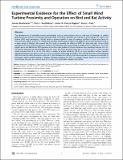Files in this item
Experimental evidence for the effect of small wind turbine proximity and operation on bird and bat activity
Item metadata
| dc.contributor.author | Minderman, J. | |
| dc.contributor.author | Pendlebury, C.J. | |
| dc.contributor.author | Pearce-Higgins, J.W. | |
| dc.contributor.author | Park, K.J. | |
| dc.date.accessioned | 2015-08-11T12:10:02Z | |
| dc.date.available | 2015-08-11T12:10:02Z | |
| dc.date.issued | 2012-07-30 | |
| dc.identifier | 174255979 | |
| dc.identifier | 1db7fa10-dea3-4dcd-a9fa-6f1e00a3129e | |
| dc.identifier | 84864430840 | |
| dc.identifier.citation | Minderman , J , Pendlebury , C J , Pearce-Higgins , J W & Park , K J 2012 , ' Experimental evidence for the effect of small wind turbine proximity and operation on bird and bat activity ' , PLoS One , vol. 7 , no. 7 , e41177 . https://doi.org/10.1371/journal.pone.0041177 | en |
| dc.identifier.issn | 1932-6203 | |
| dc.identifier.uri | https://hdl.handle.net/10023/7182 | |
| dc.description | This research was funded by a research grant from the Leverhulme Trust (a U.K. based independent charity) to Dr. Kirsty Park, grant no. F/00 241/L. This grant has now expired. | en |
| dc.description.abstract | The development of renewable energy technologies such as wind turbines forms a vital part of strategies to reduce greenhouse gas emissions worldwide. Although large wind farms generate the majority of wind energy, the small wind turbine (SWT, units generating <50 kW) sector is growing rapidly. In spite of evidence of effects of large wind farms on birds and bats, effects of SWTs on wildlife have not been studied and are likely to be different due to their potential siting in a wider range of habitats. We present the first study to quantify the effects of SWTs on birds and bats. Using a field experiment, we show that bird activity is similar in two distance bands surrounding a sample of SWTs (between 6–18 m hub height) and is not affected by SWT operation at the fine scale studied. At shorter distances from operating turbines (0–5 m), bat activity (measured as the probability of a bat ‘‘pass’’ per hour) decreases from 84% (71–91%) to 28% (11–54%) as wind speed increases from 0 to 14 m/s. This effect is weaker at greater distances (20–25 m) from operating turbines (activity decreases from 80% (65–89%) to 59% (32–81%)), and absent when they are braked. We conclude that bats avoid operating SWTs but that this effect diminishes within 20 m. Such displacement effects may have important consequences especially in landscapes where suitable habitat is limiting. Planning guidance for SWTs is currently lacking. Based on our results we recommend that they are sited at least 20 m away from potentially valuable bat habitat. | |
| dc.format.extent | 7 | |
| dc.format.extent | 613952 | |
| dc.language.iso | eng | |
| dc.relation.ispartof | PLoS One | en |
| dc.rights | Copyright 2012 Minderman et al. This is an open-access article distributed under the terms of the Creative Commons Attribution License, which permits unrestricted use, distribution, and reproduction in any medium, provided the original author and source are credited. | en |
| dc.subject | QH301 Biology | en |
| dc.subject | SDG 7 - Affordable and Clean Energy | en |
| dc.subject.lcc | QH301 | en |
| dc.title | Experimental evidence for the effect of small wind turbine proximity and operation on bird and bat activity | en |
| dc.type | Journal article | en |
| dc.contributor.institution | University of St Andrews.School of Biology | en |
| dc.identifier.doi | 10.1371/journal.pone.0041177 | |
| dc.description.status | Peer reviewed | en |
This item appears in the following Collection(s)
Items in the St Andrews Research Repository are protected by copyright, with all rights reserved, unless otherwise indicated.

